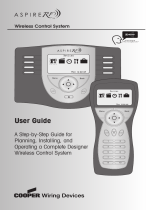MIRO: MR232 Network Controller Protocol and Command Guide Page 2
Table of Contents
1 DESCRIPTION ...................................................................................................................................4
2 INSTALLATION..................................................................................................................................4
Limitations................................................................................................................................................................................... 4
3 FEATURES ........................................................................................................................................4
4 COMMUNICATION SETTINGS.............................................................................................................5
5 WINDOWS HYPER-TERMINAL™ SETUP ............................................................................................5
6 USER INTERFACE .............................................................................................................................7
Pushbuttons................................................................................................................................................................................ 7
Status LED Indicator.................................................................................................................................................................. 8
7 SYSTEM MESSAGES..........................................................................................................................9
Group Status ............................................................................................................................................................................... 9
Ramp Group ................................................................................................................................................................................9
Cancel Ramp...............................................................................................................................................................................9
8 ASCII COMMAND OPERANDS ..........................................................................................................10
OPERAND DESCRIPTION ............................VALID ENTRIES .....................DEFAULT SETTING.......................................... 10
[0/1] Off/On ..................................................... 0 or 1.......................................................... ...........................................................10
[B] Building ID (Number) .......................... 1-7 ............................................................1 .......................................................... 10
[FT] Fade Time .............................................0-254 ........................................................2.......................................................... 10
[G] Group ID (Number) .............................. 1-4095 ....................................................... ........................................................... 10
[H] House ID (Number) ............................. 1-255.......................................................... ........................................................... 10
[MAC] Device MAC address ...........................000000-FFFFFF....................................... ...........................................................10
[P] Preset Number ....................................house 1-14, room 1-17........................... ........................................................... 10
[R] Room Number ......................................1-127.......................................................... ........................................................... 10
[RR] Ramp Rate ............................................0-100 .......................................................50.........................................................11
[RM] Rate Multiplier .....................................1-100 .......................................................30 ......................................................... 11
[TI] Time Interval ........................................0-255.......................................................... ...........................................................11
[TV] Target Value ......................................... 0-255.......................................................... ........................................................... 11
*[ ] Optional command string parameter.................................................................... ........................................................... 11
<CR> Carriage Return.................................... .................................................................... ...........................................................11
9 ASCII COMMANDS...........................................................................................................................12
BINDG – BIND Group (Device Setup)................. .................................................................... ........................................................... 13
BINDH – BIND House (House Preset-Device Setup)........................................................... ...........................................................13
BINDR – BIND Room (Room Preset-Device Setup)............................................................. ........................................................... 14
CPRR – Cancel Proportional Ramp to a Room..................................................................... ...........................................................14
CRAMP – Cancel Ramp to a Group .................... .................................................................... ........................................................... 15
GETID – Get Device IDs (Device Setup) ............. .................................................................... ........................................................... 15
GETIDL – Get Device ID’s List for whole house (Device Setup .......................................... ........................................................... 16
HELP – Interface/Command Help (Device Setup)................................................................ ........................................................... 17
IDR – Identify Room (Device Setup) ................... .................................................................... ........................................................... 17
IDG – Identify Group.............................................. .................................................................... ........................................................... 18
LNZG – Set Group to Last Non-Zero (Button Pressed)....................................................... ........................................................... 18
LNZR – Send Last Non-Zero for an entire room (Button Pressed).................................. ........................................................... 19
LOCK – LOCK House or Room (Device Setup) . .................................................................... ...........................................................19
ORHP – Over-Ride House to Preset................... .................................................................... ........................................................... 20
ORRP – Over-Ride Room to Preset.................... .................................................................... ........................................................... 20
PANIC – Control/Toggle PANIC feature (TOGGLE/ON/OFF).............................................. ........................................................... 21
PRRDN – Proportional Ramp a Room - Down. .................................................................... ...........................................................21
PRRUP – Proportional Ramp a Room - Up ...... .................................................................... ...........................................................22























